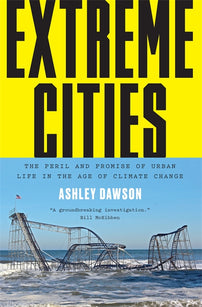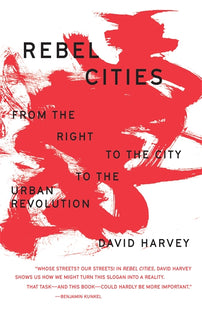Five Book Plan: Cities and Climate Change — Five Years After Hurricane Sandy
On the five-year anniversary of Hurricane Sandy, Ashley Dawson provides a select list of books and resources for assessing the history and future of cities facing climate change.
On the five-year anniversary of Hurricane Sandy, Ashley Dawson provides a select list of books and resources for assessing the history and future of cities facing climate change. Ashley Dawson is a professor of English at the City University of New York, and the author of Extinction: A Radical History. His new book, Extreme Cities: The Peril and Promise of Urban Life in the Age of Climate Change, is out now and 40% off until Monday, October 30th at 11:59PM PST.
1. Environmental Justice Network, Principles of Environmental Justice by the Delegates to the First National People of Color Environmental Leadership Summit (1991)
This is a list of the core principles that guide struggles by people of color against the destruction of their lands and communities. Drafted in 1991 at the First National People of Color Environmental Leadership Summit, the Principles identified the many omissions of the mainstream environmental movement in the US, and laid out a blueprint for radical environmental struggles in the decades to come. The document is particularly notable for its critique of colonialism and militarism, and for its call for systematic material and cultural changes to ensure the survival of frontline communities.
2. David Harvey, Rebel Cities: From the Right to the City to the Urban Revolution (Verso Books, 2013)
The task of contemporary radical politics is, as Harvey puts it in this essential series of reflections on the urban uprisings at the beginning of this decade, “to imagine and reconstitute a totally different kind of city out of the disgusting mess of a globalizing, urbanizing capital run amok.” Surveying the massive wave of urbanization that has transformed the planet over the last half-century, Harvey asks whether this dramatic transformation in the human condition has left us better off, or whether it has left us dangling in a world of alienation and anger. If urbanization is as Harvey insists directly related to the dynamics of ceaseless accumulation that characterizes capitalism, the quest for a more human form of urban life must be grounded in a vigorous anti-capitalist movement focused on the transformation of daily life in the city.
3. New York City Environmental Justice Alliance, NYC Climate Justice Agenda (2017)
With the Trump administration doing its best to roll back environmental regulations and commit planetary ecocide, the onus has fallen to progressive cities and states to advance the cause of climate justice in the US. NYC-EJA’s NYC Climate Justice Agenda offers a series of ambitious proposals for how to move forward in a time of reaction on the federal level. Building on Mayor Bill de Blasio’s commitment in OneNYC to cut the city’s greenhouse gas emissions by 80% by 2050 and to send Zero Waste to landfills by 2030, the Climate Justice Agenda tackles some of the key challenges facing NYC (and other cities) today, including mitigating the urban heat island effect, building renewable energy on an urban scale, developing food system resiliency, improving air quality, heightening coastal resiliency, and, last but certainly not least, engaging communities in all of these endeavors. The key thread that runs throughout these various proposals is the heightened vulnerability to the many effects of climate change on an urban scale experienced by predominantly people of color communities. The Climate Justice Agenda offers a host of thoughtful policy proposals to address such vulnerabilities and, in so doing, to transform the city as a whole.
4. Kate Orff, Toward an Urban Ecology: SCAPE/Landscape Architecture (The Monacelli Press, 2016)
What does it mean to practice architecture and urban design at a time of rapid, unpredictable climate change? How can design play a role in making not just buildings, landscapes, and public spaces but broader social change? Attempting to answer these questions, Orff presents a book that is part manifesto, part design manual, and philosophical monograph. Richly illustrated with images from various projects conducted by the SCAPE studio, which Orff founded to push landscape architecture in radical new directions, the book offers suggestive glimpses of what a feminist design practice for the 21st century looks like, how human communities can begin living in harmony with other species and with the natural world more broadly, and how designers can collaborate with and advance the struggles of urban communities faced with increasingly difficult natural and socio-economic challenges.
5. WE ACT, Northern Manhattan Climate Action Plan
What would a plan to climate-proof a city like New York drawn up by frontline environmental justice communities look like? The climate action plan drawn up by the Harlem-based EJ group WE ACT demonstrates how cities must build equitable communities as well as resilient infrastructure if they wish to survive the age of accelerating climate change. Consequently, in addition to calling for renewable energy-powered microgrids that will provide energy to communities through distributed networks capable of surviving a collapse of the overall grid, WE ACT’s Climate Action Plan calls for social hubs where community members can find refugee during times of disaster and deepen social cohesion and community activism at other times. Equally importantly, the action plan notes that economic empowerment must be a key element of climate-proofing, meaning that the transition to truly green cities must be anchored in the creation of well-paying, unionized jobs for local residents rather than on LEED-certified luxury condos for the few. Although it is grounded in struggles against green gentrification in America’s most polarized city, the Climate Action Plan offers an important blueprint for a more general just urban transition.
[book-strip index="1" style="display"]

